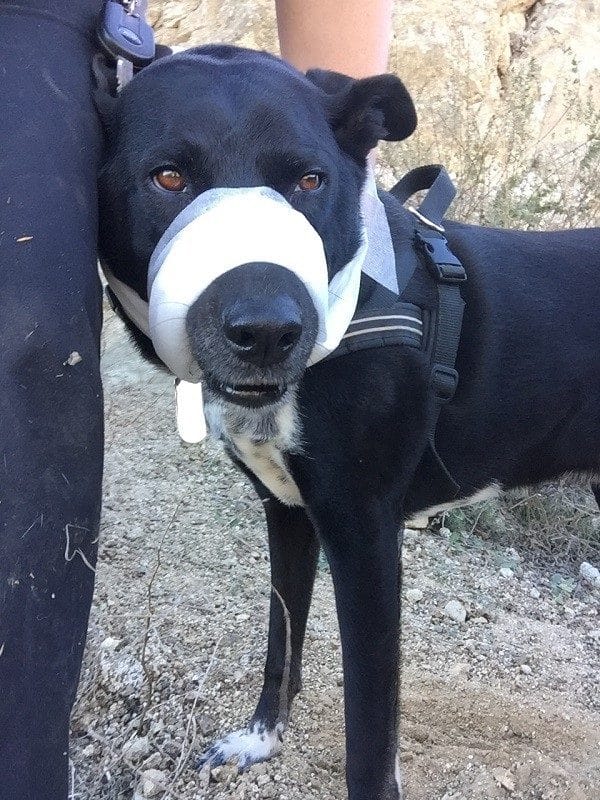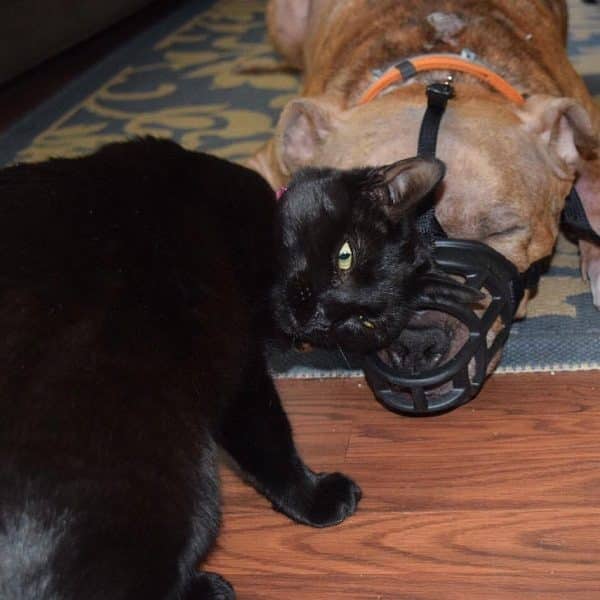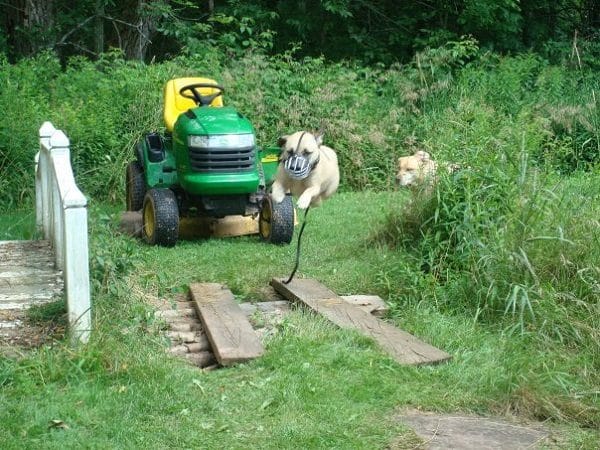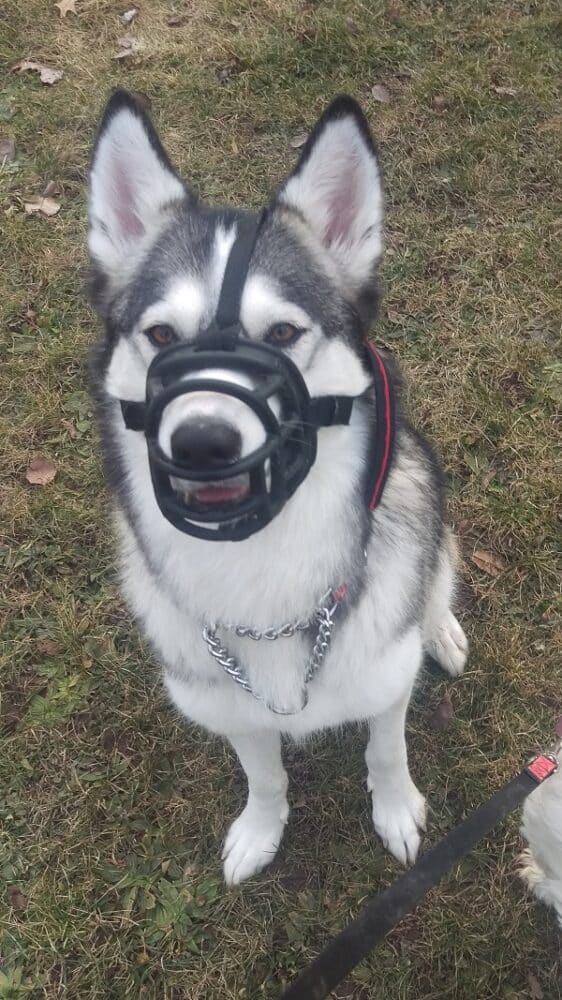At one time, I was very much against putting a muzzle on a dog. Over the years, which includes three-plus pet sitting, I’ve changed my tune. I now think there are certain times and places were a muzzle can improve safety for your dog and others. Before you get too riled up, hear me out.
When a grumpy pup needs care
One of my landlady’s dogs is an older Chihuahua, Fredo. This photogenic pup likes who he likes, when he wants to like them. This means he can spend hours sitting in my desk chair with me while I work, or it means he can snap because he doesn’t want me near him.
When Fredo heads to the vet, they often have to muzzle him for the exam. You can’t blame the poor vet. No one wants to get bit while taking a dog’s temperature!

Fredo sitting with me while I work. (Photo by Wendy Newell)
“This doesn’t count,” I can hear you say, “of course a vet should muzzle a dog for a limited amount of time for their own safety.” That’s my point. Even the most jaded anti-muzzler can accept that there is at least one time when it is good a thing.
When a pup is scared or hurt
Riggins, my adorable 11-year-old pup, is sweet as pie but also has arthritis in his hips. Recently, I bent down to pet him and in doing so hit a tender spot. The shock of me scaring him combined with him feeling pain caused him to snap at me. It was a reflex.

Riggins modeling a make shift muzzle from a doggie first aid kit. (Photo by Wendy Newell)
This incident reminded me why it’s good to muzzle dogs when they are hurt. Most pet first aid kits will either include a muzzle or a large bandage that can be used for the same purpose. It is even on the American Veterinary Medical Association‘s list of what to include in your kit. In its downloadable First Aide brochure, it warns, “Never assume that even the most gentle pet will not bite or scratch if injured. Pain and fear can make animals unpredictable or even dangerous.” You should note that the organization also says NOT to use a muzzle if your dog is vomiting.
When a dog has shown signs of hurting a person or other animal
Here is when it get’s tricky, right? This is where I will lose some of you.

King and his kitty friend. King was being treated for Cushing’s Syndrome while with the Get a Bull rescue group. Since King spent a lot of time in the vet lobby, his muzzle made him feel more comfortable. Unlike Fredo, once inside the exam room, he was able to go without it! (Photo by Sharyn Glowatz)
I’ve had to refuse good dogs for petsitting because they have escalated too fast for me to react and have harmed another animals or themselves. These escalations seemed to come out of nowhere, and after the pup had been playing happily with other dogs for hours, even days or weeks. Despite the pups being good 95 percent of the time, I have had to say “no” the next time the parents tried to book with me. I can’t put my pup and others in possible danger. For the dog who escalated, that means no fun trips hiking with his buddies and no more playtime with friends.

Kia a Mastiff mix doesn’t let her muzzle slow her down! She wears it while camping around other dogs — her folks would rather be safe than sorry. (Photo by Laura Ann Dubecky)
It is unfair to the dog who escalated. “That dog needs more training,” you are saying. Yes. You may be right. Even so, how does a pet parent or a trainer socialize a pup like that safely? When used correctly, can a well-fitting muzzle be used as a safe and productive tool?
I’m not a trainer or a behaviorist, so I can’t answer with personal expertise. I do know that as a pet parent, I would feel better if certain pups I know, who can be reactive, wore a muzzle when around Riggins. Is that me being a selfish? I reached out to dog trainer and behaviorist Michelle Huntting to ask about the use of muzzles as training tools.
Huntting is a certified dog trainer, author of a number of dog behavior and coaching books, and founder of an institute for professional dog trainers. Unlike me, SHE is a professional!
“There are definitely incidences where I have used muzzles, even for my own dogs,” Huntting explained. During her training, she is committed to getting a dog ready for anything, which is why she thinks all pet parents should take steps to desensitize their pup to wearing a muzzle. “I think it’s a good idea for every pet owner to get their dog used to a muzzle because I think it’s going to happen in their lifetime, whether it’s a medical reason or a behavioral reason.”
When I asked how she would respond to someone who looks negatively at an owner or trainer who utilizes a muzzle, Huntting described how she views the tool, “Any [training] tool, even a clicker, can be used inappropriately … I think the realization is that sometimes it (a muzzle) is a necessity to get a dog where he needs to go. It’s kinda like a training wheel on a bike. … My boys are 6 years old. I have twin boys. I just got them little bikes with training wheels on them to help them out. It’s not a long-term thing. I’d really hate for them to be 18 riding bikes with training wheels, that would be really embarrassing. We should look at it [use of a muzzle] as a stepping stone for a dog, or giving a dog a better quality of life because the owner is giving the effort to get the dog out and socialized, or maintenance while they’re training because they have multiple dogs and they are committed to making a difference.”

Cutie 2-year-old Shelby a Siberian Malamute mix. She uses a muzzle because she is fear aggressive around children from being previously abused by them. (Photo by Cassandra Potter)
What if we flip the script, and instead of looking at muzzles as evil contraptions, we see them as tools to help certain dogs and their people? What if we add positive reinforcement to show the dogs that these muzzles, when they fit well and are used correctly, aren’t something they should fear? What if we don’t look at pet parents who use them with scorn, but instead thank them for knowing what their dog needs?
What if doing all that helped keep dogs safer and happier? Wouldn’t muzzles be worth it then?
I’m interested in knowing your thoughts. Please share in the comments below.
The post Are There Appropriate Uses for a Muzzle? I Believe So appeared first on Dogster.
No comments:
Post a Comment